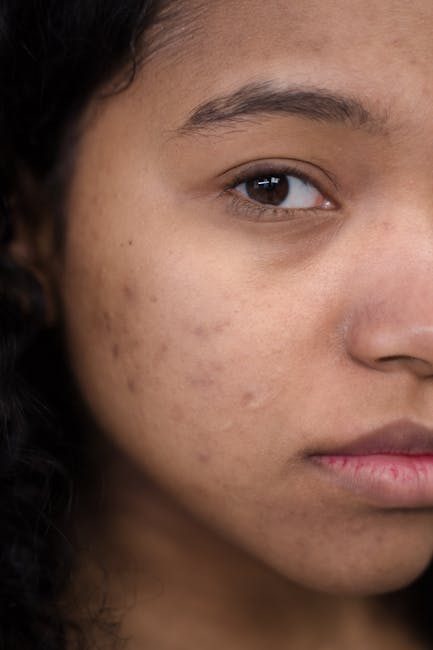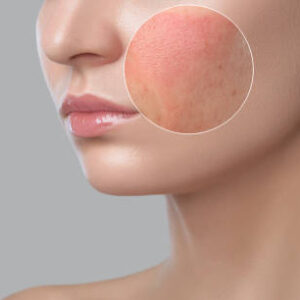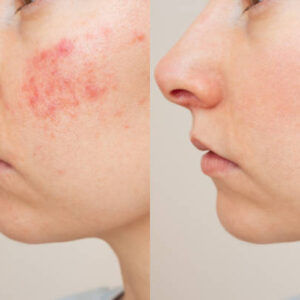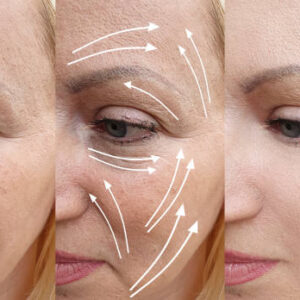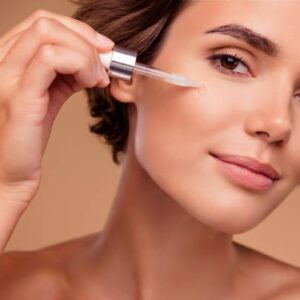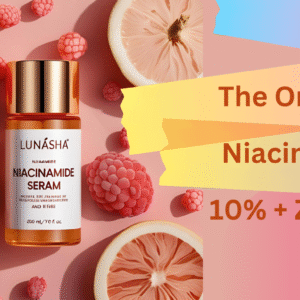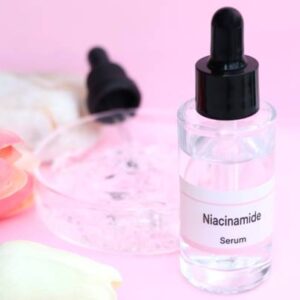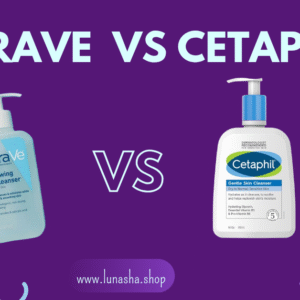Moderate acne scars prevention
The Day I Realized My Scars Weren’t Going Away on Their Own
Looking back at my teenage photos, I can’t help but cringe a little. Not because of the questionable fashion choices (though those frosted tips were… a choice), but because of what came after those painful breakouts disappeared. I thought once the acne was gone, that would be it. oh Boy, was I wrong!
I remember standing in my college dorm, running my fingers over the textured patches on my cheeks and chin. Those weren’t just “marks” that would fade with time like my mom kept insisting. These were legitimate moderate acne scars, and they were apparently here to stay. That moment of realization hit me like a truck – I’d have to actually do something about this.
What I didn’t know then was that I was dealing with what dermatologists classify as moderate acne scarring. It wasn’t the severe, deep ice-pick scars that some people struggle with, but it definitely wasn’t the mild post-inflammatory hyperpigmentation that fades on its own either. I was stuck somewhere in the middle, which honestly felt like the worst place to be.
Understanding Moderate Acne Scars: What Nobody Tells You
Let me break down what moderate acne scars actually are, because I wish someone had explained this to me years earlier. Moderate acne scars are typically the rolling scars and shallow boxcar scars that give your skin that uneven, textured appearance. They’re not as deep as severe scarring, but they’re definitely noticeable, especially in certain lighting conditions.
The thing about moderate acne scars is they’re sneaky. In soft, diffused light, your skin might look pretty decent. But step under fluorescent lights or catch your reflection in direct sunlight? Yeah, that’s when they decide to make their grand appearance. I learned this the hard way during job interviews and first dates.
Rolling scars, which made up most of my scarring, are those wave-like indentations that give skin a rolling or undulating appearance. They’re caused by bands of scar tissue that form under the skin, pulling it down in certain areas. Boxcar scars, on the other hand, are those round or oval depressions with steep sides – kind of like tiny craters on your face.
The frustrating part about moderate acne scars is that they’re often dismissed by people who don’t understand. “They’re not that bad,” friends would say, which honestly made me feel worse. Just because they weren’t severe didn’t mean they weren’t affecting my confidence and self-esteem.
Its time for me to do dig deep………….
The Types of Acne Scars I Dealt With (And You Might Too)
During my dermatologist consultation – which took me way too long to finally book – I learned there are actually several different types of acne scars. Understanding which type you have is crucial for choosing the right treatment approach.
Rolling Scars: These were my main issue. They create that wavy, uneven texture across the skin surface. The dermatologist explained that these form when bands of scar tissue develop between the skin and underlying tissue, pulling the epidermis down. They’re typically wider than other scar types but not as deep.
Boxcar Scars: I had a few of these mixed in, particularly on my temples. They look like round or oval depressions with well-defined, steep edges. Think of them as mini craters in your skin. They can be shallow (which is what I had) or deep, depending on how much tissue was lost during the inflammatory process.
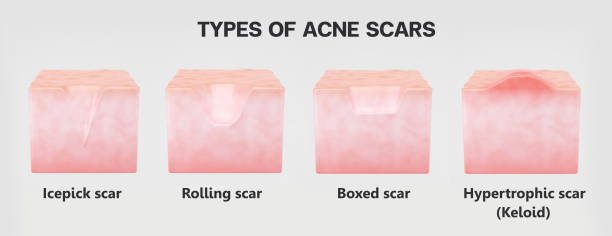
Ice Pick Scars: Thankfully, I didn’t have many of these, but the few I had were on my nose. These are narrow, deep scars that extend into the dermis. They got their name because they look like someone took an ice pick to your skin. They’re the most challenging to treat because of their depth.
Hypertrophic and Keloid Scars: These are raised scars that form when your body produces too much collagen during healing. I had a couple small ones along my jawline. Unlike the other types, these stick up from the skin surface instead of creating depressions.
The mix of scar types I had made treatment planning more complex. What works great for rolling scars might not be as effective for boxcar scars, and vice versa. This is why getting a proper evaluation from a dermatologist was so important.
My Biggest Acne Scar Prevention Mistakes (Learn from My Failures)
Here’s where I need to be brutally honest about my teenage and early adult mistakes. If you’re currently dealing with active acne, please learn from what I did wrong, because prevention is so much easier than treatment.
Mistake #1: The Picking Habit I was a chronic picker. Stress from school, boredom during study sessions, standing in front of the mirror – any excuse and my fingers would find their way to my face. You’re less likely to develop acne scars if you break out less. Avoid picking, popping, or squeezing any breakout, no matter how tempting, to prevent irritating the skin and damaging the underlying tissue, which can lead to scars. Every single dermatologist I’ve talked to since has emphasized this point, and I completely ignored it when it mattered most.
The worst part was that I thought I was being helpful. “I’m just helping the pimple drain,” I’d tell myself. What I was actually doing was pushing bacteria deeper into my skin, causing more inflammation, and damaging the surrounding tissue that would eventually become scar tissue.

Mistake #2: Ignoring Active Acne Treatment I figured my acne would just go away on its own eventually. Spoiler alert: it didn’t. Early treatment of active acne remains the best way to prevent or limit acne-related scarring. By the time I finally sought treatment, I’d already accumulated years of damage that could have been prevented.
Mistake #3: DIY Treatments Gone Wrong YouTube and early internet forums convinced me I could handle this myself. I tried everything from lemon juice (terrible idea – it made my skin photosensitive and actually caused more damage) to baking soda scrubs (way too harsh and probably contributed to some of the scarring). Home remedies might work for some people, but for moderate to severe acne, professional treatment is usually necessary.
Mistake #4: Inconsistent Skincare I’d use products religiously for two weeks, see no immediate results, and then abandon them for something else. Skincare isn’t instant gratification, and my impatience definitely worked against me. Consistent, gentle care over months and years is what actually makes a difference.
Mistake #5: Sun Exposure Without Protection I spent way too many summers lifeguarding without proper sun protection on my face. UV exposure can worsen both active acne inflammation and post-inflammatory hyperpigmentation, making scars more likely to form and more noticeable once they do.
Why Prevention Should Be Your Top Priority
If you’re currently dealing with active acne, I cannot stress this enough: focus on prevention first. Treating existing scars is expensive, time-consuming, and sometimes not completely successful. But preventing new scars? That’s something you have significant control over.
These include seeking treatment while acne is present and avoiding Picking, Popping, or Touching acne, which may lead to infections and a higher chance of scarring. The key is getting your active acne under control as quickly as possible and maintaining that control consistently.
I always make joke about making PPT (Picking,Popping,Touching). Not all PPT make you PRENSANTABLE! . Jokes on me .
Here’s what I wish I’d known about prevention:
Gentle, Consistent Skincare is King I thought aggressive scrubbing and harsh products were the answer. Wrong. Gentle cleansing with a mild, non-comedogenic cleanser twice daily is much more effective. Over-cleansing and harsh scrubbing actually increase inflammation, which increases scarring risk.
Professional Treatment for Persistent Acne If you’ve been dealing with acne for more than a few months and over-the-counter treatments aren’t working, see a dermatologist. Don’t wait years like I did. Prescription retinoids, antibiotics, or other treatments can get acne under control much faster than DIY approaches.
Hands Off Policy This was my hardest lesson to learn. Every time you pick, pop, or squeeze a pimple, you’re increasing the risk of scarring. I know it’s satisfying in the moment, but the long-term consequences aren’t worth it. If you absolutely can’t resist, at least do extractions properly with clean tools and proper technique, or better yet, have them done professionally.
Sun Protection is Non-Negotiable UV exposure increases inflammation and can make acne worse, plus it increases the risk of post-inflammatory hyperpigmentation. A broad-spectrum SPF 30 or higher should be part of your daily routine, not just for beach days.
My Treatment Journey: What Worked, What Didn’t, and What I Learned
After finally accepting that my scars weren’t going to fade on their own, I started researching treatment options. Various procedures can improve acne scars, but no single treatment is best for everyone. This became very apparent as I navigated the world of scar treatments.
Round 1: Over-the-Counter Attempts I started with drugstore scar treatments and vitamin C serums. While these didn’t make a dramatic difference in my moderate scarring, they did help with some of the post-inflammatory hyperpigmentation I was still dealing with. Products with ingredients like niacinamide, vitamin C, and gentle exfoliating acids can be helpful for surface-level improvements.
The key with OTC treatments is managing expectations. They’re not going to transform moderate scarring, but they can provide subtle improvements over several months of consistent use. I used these for about six months before moving on to professional treatments.
Round 2: Chemical Peels My dermatologist recommended starting with a series of chemical peels. I did six medium-depth peels over the course of eight months. The downtime was manageable – usually 3-5 days of peeling and redness – but the results were pretty subtle for my type of scarring.
Chemical peels work better for surface-level scarring and hyperpigmentation than they do for the deeper, structural issues that characterize moderate acne scarring. They did improve my skin texture somewhat and helped with some shallow scarring, but the rolling scars remained largely unchanged.
Round 3: Microneedling Series This is where I started seeing more noticeable results. Microneedling can help for mild to moderate atrophic scars. Like a laser, microneedling creates a controlled injury. The injury stimulates the body’s natural healing response and triggers collagen production.
I did six microneedling sessions spaced about six weeks apart. The treatment itself isn’t pleasant – it feels like someone is rolling sandpaper across your face – but it’s tolerable. The real challenge was the downtime. My face would be red and swollen for 2-3 days after each session, and I’d look like I had a mild sunburn for about a week.
The results were gradual but noticeable. After the full series, the texture of my skin was significantly improved. The rolling scars were still there, but they were much less pronounced. My skin looked smoother overall, and makeup went on much better.
Round 4: Laser Resurfacing For the remaining scarring, my dermatologist recommended fractional laser resurfacing. This was more aggressive than the microneedling, with more downtime but potentially better results for stubborn scars.
I did two sessions of fractional CO2 laser treatment, spaced three months apart. The downtime was significant – about a week of looking pretty rough, with peeling, redness, and swelling. But the results were worth it. The remaining moderate scarring improved significantly, and my overall skin texture became much smoother.
The Real Results: Before and After My Treatment Journey
After two years of various treatments, here’s where I ended up: my moderate acne scars improved by about 60-70%. That might not sound like 100% success, but honestly, it was life-changing for my confidence.
The rolling scars that used to create that wave-like texture across my cheeks are now barely noticeable in most lighting. The shallow boxcar scars have filled in significantly, though they’re not completely gone. The few ice pick scars I had are still visible if you look closely, but they’re much less noticeable.
More importantly, my skin texture is now smooth enough that I feel comfortable going makeup-free on casual days. Before treatment, I wouldn’t leave the house without foundation and concealer. Now, a little tinted moisturizer is usually enough.
The psychological impact has been huge. I no longer avoid certain lighting situations or angle my face away from people during conversations. Photography doesn’t make me anxious anymore. These might seem like small things, but they made a big difference in my daily life.
It’s worth noting that results vary significantly from person to person. Factors like your age, skin type, scar depth, and how your skin responds to treatment all play a role. Some people see better results than I did, others see less improvement. Managing expectations is important.
The Honest Pros and Cons of Acne Scar Treatment
After going through this entire process, I want to give you the real picture of what acne scar treatment involves, because it’s not all sunshine and smooth skin.
The Pros:
- Significant improvement in skin texture and appearance
- Increased confidence and self-esteem
- Better makeup application when you do choose to wear it
- Improved skin health overall
- Long-lasting results (it’s been three years since my last treatment and results have held up well)
The Cons:
- Expensive (I spent about $4,000 total over two years)
- Time-consuming (multiple appointments, planning around downtime)
- Sometimes painful (especially laser treatments)
- Results aren’t immediate – patience is required
- Not covered by insurance since it’s considered cosmetic
- Some treatments require avoiding sun exposure for weeks afterward
The Reality Check: Treatment helped tremendously, but it didn’t give me perfect skin. I still have some visible scarring, and I still break out occasionally (though much less frequently now that I have a good skincare routine). The goal isn’t perfection – it’s improvement to a point where you feel comfortable and confident in your skin.
Finding Your Path: Treatment Options for Different Budgets and Timelines
Not everyone can afford or commit to the treatment path I took, and that’s okay. There are options for different budgets and comfort levels.
Budget-Friendly Approaches:
- Consistent use of OTC retinoids and vitamin C serums
- At-home microneedling devices (though professional treatments are more effective)
- Chemical exfoliants like glycolic or lactic acid
- Silicone scar sheets for newer scars
- Proper sun protection to prevent worsening
Mid-Range Options:
- Professional chemical peels
- Microneedling sessions
- Prescription retinoids like tretinoin
- Professional facials with extractions
Higher-End Treatments:
- Laser resurfacing
- Radiofrequency treatments
- Combination therapy approaches
- Surgical scar revision for severe cases
The key is starting where you’re comfortable and seeing how your skin responds. You can always step up to more aggressive treatments later if needed.
Who Should (and Shouldn’t) Consider Acne Scar Treatment
Acne scar treatment isn’t right for everyone, and there are some important factors to consider before diving in.
Good Candidates for Treatment:
- People with realistic expectations about results
- Those who have active acne under control (treating scars while still breaking out regularly isn’t effective)
- Individuals who can commit to proper aftercare and sun protection
- People who understand that multiple treatments are usually needed
- Those who have scarring that bothers them enough to justify the time, cost, and discomfort
People Who Should Wait or Consider Alternatives:
- Anyone still dealing with active, inflammatory acne (get this under control first)
- People with unrealistic expectations about achieving perfect skin
- Those who can’t avoid sun exposure or won’t commit to proper aftercare
- Individuals with certain medical conditions or taking medications that affect healing
- People considering treatment primarily due to pressure from others rather than personal desire
Special Considerations: If you have darker skin, certain treatments carry higher risks of hyperpigmentation or hypopigmentation. Make sure your provider has experience treating your skin type and can recommend appropriate treatment modifications.
Pregnant or breastfeeding women should avoid most professional scar treatments. Similarly, people with active cold sores or certain autoimmune conditions may need to postpone treatment.
Age is also a factor. While there’s no “wrong” age for treatment, younger people (teens and early twenties) might want to wait until their acne is completely under control before investing in scar treatment, as new breakouts can create new scarring.
Realistic Expectations: What Treatment Can and Can’t Do
This is probably the most important section of this entire article, because managing expectations is crucial for satisfaction with results.
What Scar Treatment CAN Do:
- Improve skin texture significantly (usually 50-80% improvement)
- Make scars less noticeable in most lighting conditions
- Reduce the depth and width of moderate scarring
- Improve overall skin tone and smoothness
- Boost confidence and self-esteem
- Make makeup application easier and more natural-looking

What Scar Treatment CAN’T Do:
- Achieve completely perfect, pore-less skin
- Eliminate 100% of all scarring
- Prevent future breakouts (though it often improves overall skin health)
- Work the same way for everyone
- Provide instant results
- Replace good skincare habits
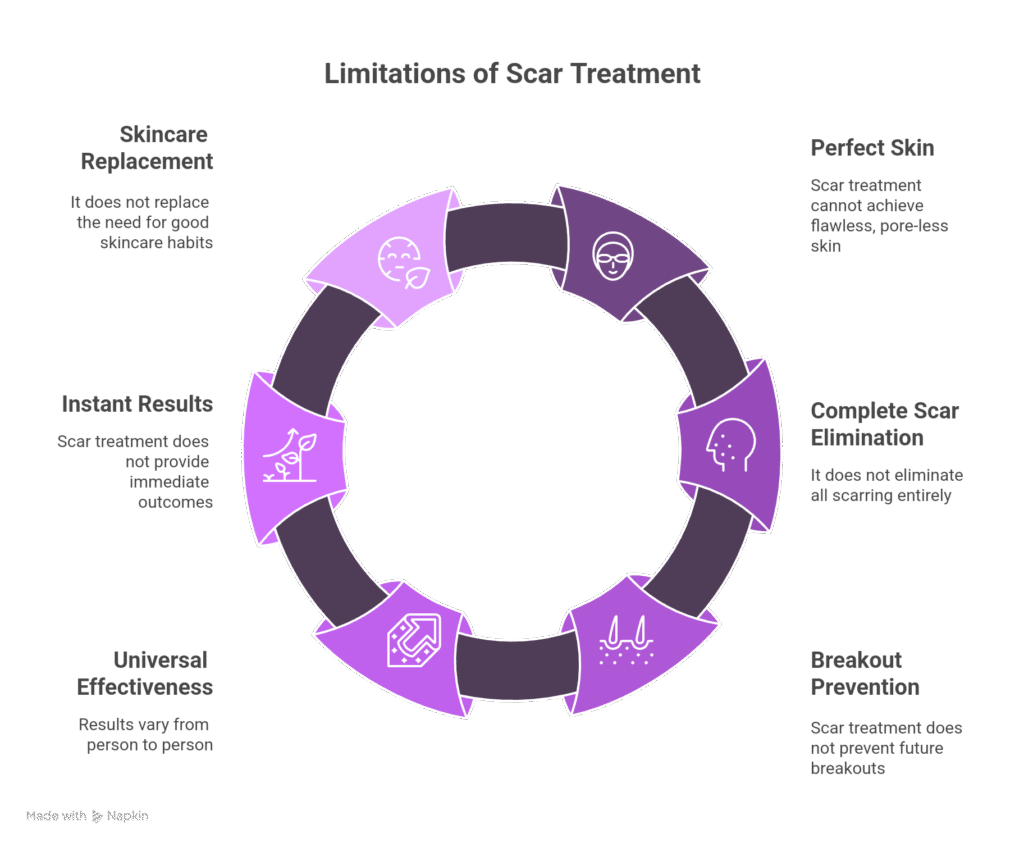
The goal should be significant improvement, not perfection. I learned this lesson the hard way by initially expecting my skin to look like it did before I ever had acne. That’s not realistic for most people with moderate scarring.
The Maintenance Phase: Keeping Your Results
Something I wasn’t prepared for was the ongoing maintenance required to keep my results looking their best. Acne scar treatment isn’t a one-and-done situation.
I now maintain my results with:
- Consistent use of tretinoin (prescription retinoid)
- Regular professional facials every 6-8 weeks
- Daily SPF 50 sunscreen, no exceptions
- Gentle exfoliation with glycolic acid 2-3 times per week
- Annual “touch-up” microneedling sessions
This might sound like a lot, but it’s actually become routine. The tretinoin and sunscreen are non-negotiable daily steps. The facials and touch-up treatments are scheduled maintenance, like getting your car serviced.
Without maintenance, some of the improvement can fade over time. Your skin continues to age and lose collagen, so the structure that was rebuilt during treatment needs ongoing support.
Where to Get Treatment and What to Look For
Choosing the right provider is crucial for getting good results safely. After trying a few different places, here’s what I learned to look for:
Essential Qualifications:
- Board-certified dermatologist or plastic surgeon
- Extensive experience with acne scar treatment specifically
- Before/after photos of patients with similar skin types and scarring patterns
- Willingness to discuss realistic expectations honestly
- Proper medical facility with appropriate safety measures
Red Flags to Avoid:
- Providers who promise perfect results or guarantee specific outcomes
- Facilities that push you toward the most expensive treatments immediately
- Anyone who won’t show you before/after photos of their work
- Practitioners who don’t assess your skin type and scarring pattern carefully
- Places that seem more focused on selling packages than individualized treatment
Questions to Ask During Consultation:
- How many patients with my type of scarring have you treated?
- What realistic improvement can I expect?
- What are the risks and potential side effects?
- How many treatments will I likely need?
- What’s the total expected cost?
- What does aftercare involve?
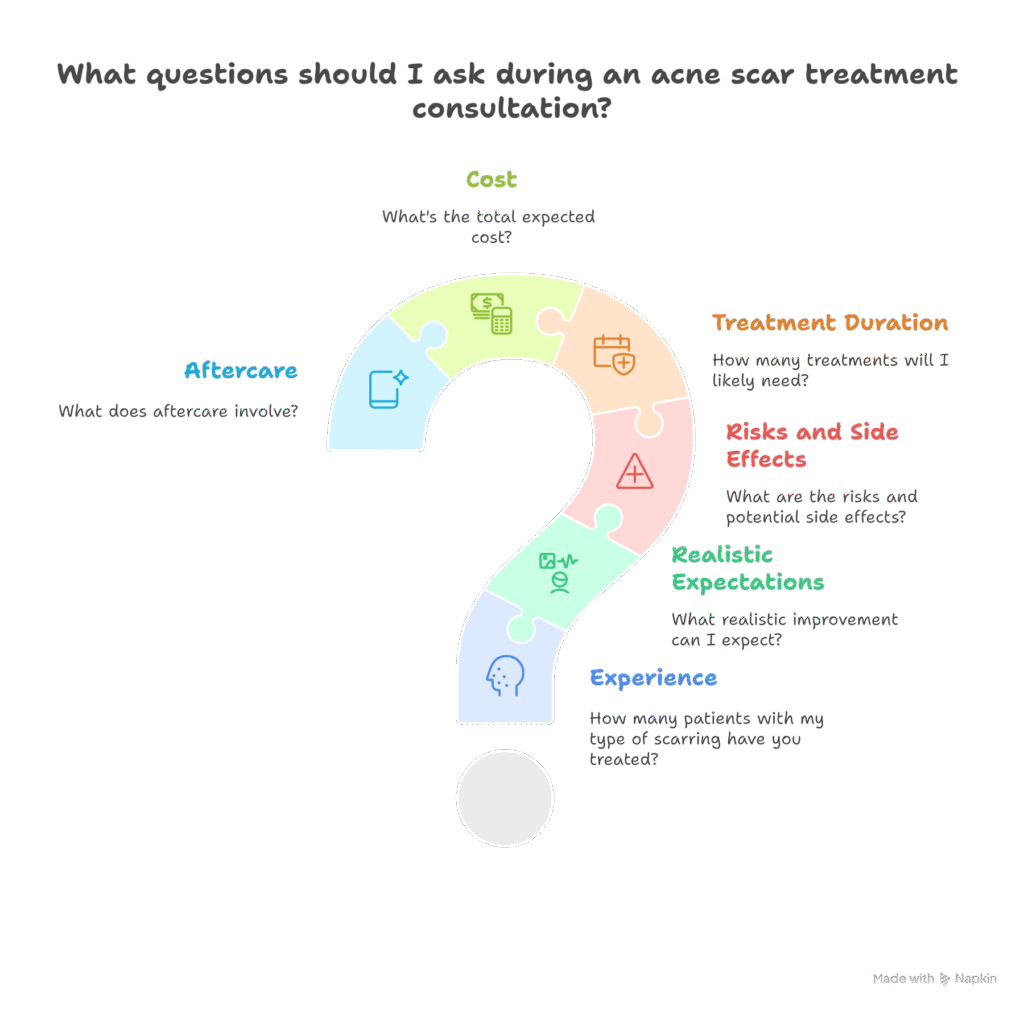
Don’t be afraid to get second opinions, especially for more aggressive treatments. I consulted with three different providers before choosing who to work with for my laser treatments.
Current Deals and Where to Find Treatment
Treatment costs vary significantly depending on your location and the provider, but here are some ways to make it more affordable:
Many dermatology practices offer package deals for multiple sessions, which can save 10-20% compared to individual treatments. Some also offer seasonal promotions, particularly in fall and winter when people are less concerned about sun exposure during healing.
Medical spas often have financing options or payment plans that can make treatment more accessible. CareCredit is commonly accepted for cosmetic procedures.
Some medical schools with dermatology programs offer discounted treatments performed by residents under supervision. The providers are still highly trained, but costs are typically lower.
Group buying sites like Groupon sometimes have deals for basic treatments like chemical peels or microneedling, but be extra careful to verify the provider’s credentials when going this route.
The Emotional Side: Dealing with Acne Scar Anxiety
I don’t think people talk enough about the emotional impact of acne scarring. It’s not just about appearance – it affects how you interact with the world.
Before treatment, I had developed habits I didn’t even realize were related to my scars. I’d angle my face away from people during conversations. I avoided certain lighting situations. I’d cancel plans if my skin looked particularly bad that day. Photography made me anxious.
The psychological impact of improvement was actually more significant than I expected. It wasn’t just that my skin looked better – I felt more comfortable engaging with people. I stopped checking mirrors constantly or worrying about how my skin looked in different lighting.
If you’re struggling with the emotional aspects of acne scarring, know that it’s completely normal and valid. Don’t let anyone minimize how it affects you. At the same time, try not to let it completely define your self-worth or limit your life experiences.
Consider talking to a counselor or therapist if acne scarring is significantly affecting your mental health or daily functioning. Sometimes working on the emotional side alongside the physical treatment can be really helpful.
My Current Skincare Routine for Scar-Prone Skin
After years of trial and error, here’s the routine that keeps my skin stable and helps maintain my treatment results:
Morning:
- Gentle cleanser (CeraVe Foaming Facial Cleanser)
- Vitamin C serum (SkinCeuticals C E Ferulic – expensive but worth it for me)
- Moisturizer with niacinamide
- SPF 50 sunscreen (EltaMD UV Clear – doesn’t pill under makeup)
Evening:
- Oil cleanser if wearing makeup
- Same gentle cleanser
- Tretinoin 0.1% (prescription – started at 0.025% and worked up)
- Moisturizer
- Facial oil if skin feels dry
Weekly:
- Glycolic acid exfoliant 2-3 times per week (on nights I don’t use tretinoin)
- Hydrating mask once per week
The key is consistency and gentleness. I learned that aggressive, complicated routines often do more harm than good, especially for scar-prone skin.
Frequently Asked Questions About Moderate Acne Scars
Q: How long does it take to see results from acne scar treatment? Most treatments require multiple sessions spaced weeks apart, with results becoming noticeable after 2-3 sessions. Full results typically take 6-12 months to develop as your skin produces new collagen. Patience is essential because improvement happens gradually.
Q: Can moderate acne scars be completely eliminated? Complete elimination is rare, but significant improvement (50-80%) is achievable for most people with moderate scarring. The goal should be improvement to a point where scars are barely noticeable rather than perfect skin.
Q: What’s the difference between acne scars and acne marks? Acne marks (post-inflammatory hyperpigmentation) are flat, colored spots that fade over time. Acne scars involve actual changes to skin texture – depressions or raised areas that don’t fade on their own and typically require professional treatment.
Q: Is it safe to treat acne scars while still getting occasional breakouts? It is also imperative to ensure active acne has been treated before approaching scar treatment so as not to create a cycle where active lesions continue to scar in areas already addressed. Occasional minor breakouts are usually okay, but ongoing inflammatory acne should be controlled first.
Q: How much does moderate acne scar treatment typically cost? Costs vary widely by location and treatment type. Chemical peels range from $150-500 per session. Microneedling costs $200-700 per session. Laser treatments can cost $1,000-3,000 per session. Most people need 3-6 sessions for optimal results.
Q: Can I prevent acne scars if I already have acne? Yes! Avoid picking, popping, or squeezing any breakout, no matter how tempting, to prevent irritating the skin and damaging the underlying tissue, which can lead to scars. Early professional treatment of active acne is the best prevention strategy.
Q: Do at-home treatments work for moderate acne scars? At-home treatments like retinoids, vitamin C, and gentle chemical exfoliants can provide subtle improvements over time, but moderate scarring typically requires professional treatment for significant results. At-home microneedling devices can help but aren’t as effective as professional treatments.
Q: How do I know if my acne scarring is considered “moderate”? Moderate acne scarring typically includes rolling scars and shallow to moderate boxcar scars that create noticeable texture changes but aren’t deeply indented. If you’re unsure, a dermatologist can assess your scarring severity and recommend appropriate treatments.
Q: Can makeup cover moderate acne scars effectively? Good quality makeup can significantly reduce the appearance of moderate acne scars. Primer helps smooth texture, while full-coverage foundation and concealer can mask color differences. However, treatment often makes makeup application easier and more natural-looking.
Q: What should I avoid after acne scar treatments? After most treatments, avoid sun exposure, harsh skincare products, picking at healing skin, and activities that cause excessive sweating for the first week. Your provider will give specific aftercare instructions based on your treatment type.
Final Thoughts: Your Skin Journey is Unique
Looking back on my acne scar journey, I wish someone had told me that it’s okay to take time to figure out what works for you. There’s no single “right” approach, and what worked for me might not be the best path for you.
The most important thing I learned is that dealing with acne scars – whether through treatment, acceptance, or a combination of both – is a personal decision. Don’t let anyone pressure you into treatment you’re not ready for, but also don’t let fear or misinformation prevent you from exploring options that might help.
Your worth isn’t determined by your skin texture, but if scarring is affecting your confidence and quality of life, know that effective treatments exist. Take time to research, consult with qualified professionals, and make decisions that feel right for your situation and goals.
Remember that improvement is a realistic goal, and even partial improvement can have a significant impact on how you feel about your skin. Be patient with the process, gentle with yourself, and realistic about outcomes.

